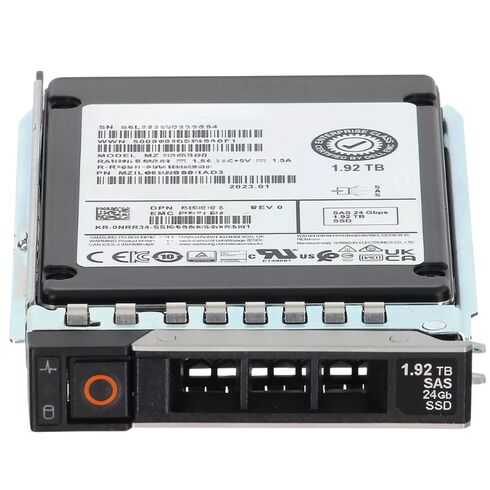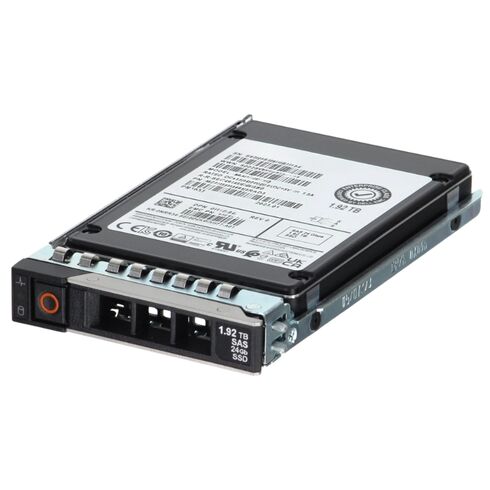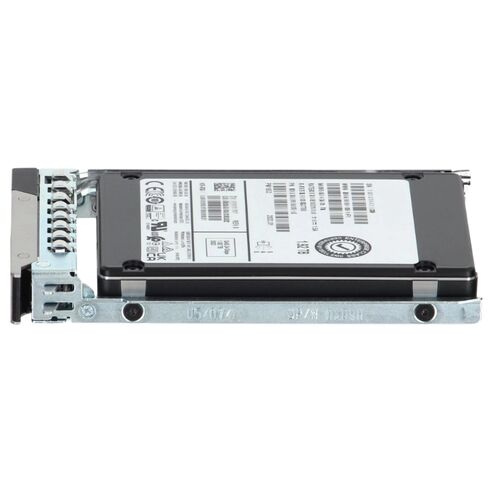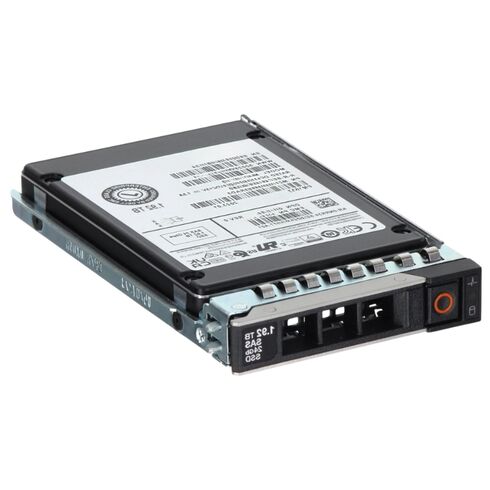183C9 Dell 1.92TB SAS 12GBPS 512e SSD
- — Free Ground Shipping
- — Min. 6-month Replacement Warranty
- — Genuine/Authentic Products
- — Easy Return and Exchange
- — Different Payment Methods
- — Best Price
- — We Guarantee Price Matching
- — Tax-Exempt Facilities
- — 24/7 Live Chat, Phone Support
- — Visa, MasterCard, Discover, and Amex
- — JCB, Diners Club, UnionPay
- — PayPal, ACH/Bank Transfer (11% Off)
- — Apple Pay, Amazon Pay, Google Pay
- — Buy Now, Pay Later - Affirm, Afterpay
- — GOV/EDU/Institutions PO's Accepted
- — Invoices
- — Deliver Anywhere
- — Express Delivery in the USA and Worldwide
- — Ship to -APO -FPO
- — For USA - Free Ground Shipping
- — Worldwide - from $30
Product Specifications of Dell 1.92TB 183C9 SSD
- Brand: Dell
- Part Number: 183C9
- Product Line: Solid State Drive
Overview of Features
Device Characteristics
- Type: Solid State Drive
- Storage Capacity: 1.92 TB
- Interface Type: SAS 12 Gbps
- Form Factor: 2.5-Inch
Performance and Endurance
- Read Intensive: Optimized for read-heavy workloads
- 512 Emulation: Supports 512e for compatibility
Connectivity Options
Expansion Capabilities
- Interface Ports: 1 x SAS 12 Gbps
- Bays Supported: 1 x 2.5-Inch
System Compatibility
Supported Systems
- Compatible with: PowerEdge C4130
Key Advantages
Choose This SSD
- Enhanced performance for demanding applications
- Reliable data access with high read speeds
- Seamless integration with existing systems
- Hot-plug capability for easy maintenance
Interface: SAS 12GBPS
SAS stands for Serial Attached SCSI, which is a technology used for connecting storage devices to a computer system. It is a high-speed interface that provides reliable and efficient data transfer between the storage device and the computer. The SAS interface is widely used in enterprise-level storage systems due to its performance and scalability.
Benefits of SAS 12GBPS
The Dell 1.92TB 183C9 SSD features the SAS 12GBPS interface, which offers several benefits to users:
1. Enhanced Performance
The SAS 12GBPS interface provides significantly faster data transfer rates compared to its predecessors. With a higher bandwidth, it allows for quicker access to stored data, resulting in improved overall system performance. This is particularly advantageous for applications that require fast and efficient data processing, such as databases, virtualization, and high-performance computing.
2. Increased Scalability
One of the key advantages of SAS is its ability to support multiple devices through daisy-chaining. The SAS 12GBPS interface allows for easy expansion of storage capacity by connecting multiple drives in a series, without compromising performance. This scalability feature is crucial for businesses that require flexible and easily expandable storage solutions.
3. Reliability and Data Integrity
SAS technology incorporates advanced error detection and correction mechanisms, ensuring data integrity during transmission. The interface includes features such as cyclic redundancy check (CRC) and end-to-end data integrity checks, which minimize the risk of data corruption or loss. This reliability is essential for critical applications that cannot afford any data errors or downtime.
4. Compatibility
Another advantage of the SAS 12GBPS interface is its backward compatibility with previous SAS generations and SATA drives. This means that the Dell 1.92TB 183C9 SSD can be easily integrated into existing storage infrastructures without requiring a complete overhaul. It provides users with the flexibility to upgrade their storage systems gradually, according to their specific needs and budget.
Importance of SAS 12GBPS for Users
1. Enterprise-level Performance
The SAS 12GBPS interface is designed to meet the demanding requirements of enterprise-level applications. It enables businesses to handle large amounts of data quickly and efficiently, resulting in improved productivity and reduced processing times. With the Dell 1.92TB 183C9 SSD's SAS 12GBPS interface, users can experience seamless and high-performance storage operations, even in resource-intensive environments.
2. Future-Proof Investment
Investing in storage solutions with the SAS 12GBPS interface ensures compatibility with future technologies and advancements. As technology continues to evolve, storage requirements will increase, and faster interfaces will become more prevalent. By choosing the Dell 1.92TB 183C9 SSD with SAS 12GBPS, users can future-proof their storage infrastructure, avoiding the need for immediate upgrades when faster interfaces become mainstream.
3. Reduced Latency
The faster data transfer rates offered by the SAS 12GBPS interface result in reduced latency, which is crucial for applications that require real-time data access. Industries such as finance, telecommunications, and scientific research heavily rely on low latency storage systems to process large volumes of data quickly. The Dell 1.92TB 183C9 SSD's SAS 12GBPS interface ensures minimal delays in data retrieval, enabling smooth and uninterrupted operations.
4. High Availability
In enterprise environments, downtime can be costly and disruptive. The SAS 12GBPS interface provides high availability features, such as hot-plugging, redundant paths, and failover support. These features ensure continuous data access and minimize the impact of hardware failures or maintenance activities. With the Dell 1.92TB 183C9 SSD's SAS 12GBPS interface, users can rely on a stable and resilient storage solution for their critical business operations.
Usage: Read Intensive
Read Intensive is a term used to describe a workload or usage pattern where the majority of operations performed on a storage device are read operations. This type of workload typically involves applications that require fast and frequent read access to stored data, such as web servers, content delivery networks (CDNs), and data analytics platforms.
Benefits of Read Intensive SSDs
The Dell 1.92TB 183C9 SSD is specifically designed for Read Intensive workloads, offering several benefits to users:
1. Enhanced Read Performance
Read Intensive SSDs prioritize read operations, optimizing their performance characteristics accordingly. These drives are designed to deliver fast and consistent read speeds, enabling quick data retrieval for applications that heavily rely on read access. The Dell 1.92TB 183C9 SSD's Read Intensive design ensures efficient and responsive performance for read-intensive workloads.
2. Longer Lifespan
Read Intensive SSDs are engineered to withstand high read workloads over an extended period without compromising reliability or endurance. By prioritizing read operations, these drives minimize write amplification and reduce the wear on the flash memory cells. As a result, the Dell 1.92TB 183C9 SSD offers a longer lifespan compared to drives optimized for mixed workloads or write-intensive applications.
3. Cost-Effective Solution
Read Intensive SSDs are typically more cost-effective than their write-intensive counterparts. Since read operations have lower write amplification and less impact on flash memory endurance, manufacturers can offer these drives at a lower price point. The Dell 1.92TB 183C9 SSD's Read Intensive design provides users with an affordable yet reliable storage solution for their read-heavy applications.
4. Improved Energy Efficiency
Read Intensive SSDs consume less power compared to drives optimized for write-intensive workloads. Since read operations are less resource-intensive, these drives require fewer resources to perform their tasks, resulting in lower energy consumption. By using the Dell 1.92TB 183C9 SSD's Read Intensive design, users can benefit from improved energy efficiency, reducing operational costs and environmental impact.
Importance of Read Intensive for Users
1. Accelerated Data Access
Read Intensive SSDs excel at delivering fast and responsive data access, making them ideal for applications that heavily rely on read operations. Whether it's a web server serving content to users or a data analytics platform retrieving large datasets, the Dell 1.92TB 183C9 SSD's Read Intensive design ensures optimized performance and reduced latency, resulting in a smooth and efficient user experience.
2. Cost-Effective Storage Solution
For users with read-intensive workloads, investing in a Read Intensive SSD like the Dell 1.92TB 183C9 SSD can provide significant cost savings. These drives offer a balance between performance and price, making them an attractive option for businesses looking to optimize their storage infrastructure while staying within budget. The cost-effectiveness of Read Intensive SSDs allows users to allocate their resources efficiently without sacrificing performance.
3. Extended Drive Lifespan
By utilizing an SSD specifically designed for read-intensive workloads, users can prolong the lifespan of their storage device. The Dell 1.92TB 183C9 SSD's Read Intensive design minimizes write amplification, reducing the wear on the flash memory cells. This translates to increased reliability and durability, ensuring that the drive can handle high read workloads without premature failure. The extended lifespan of the drive provides users with a reliable and long-lasting storage solution.
4. Energy Efficiency
Energy efficiency is a crucial consideration for businesses aiming to reduce operational costs and minimize their carbon footprint. Read Intensive SSDs consume less power compared to drives optimized for write-intensive workloads, resulting in lower energy consumption. By choosing the Dell 1.92TB 183C9 SSD's Read Intensive design, users can contribute to energy conservation efforts while maintaining high-performance storage for their read-heavy applications.
Sector Size: 512e
The term "512e" refers to a sector size of 512 bytes emulated on disk drives that use advanced format technologies. Advanced format drives utilize larger physical sectors internally to improve efficiency and storage density. However, to maintain compatibility with legacy systems and software that are designed for the standard 512-byte sector size, these drives emulate a 512-byte sector size on the logical level.
Benefits of 512e Sector Size
The Dell 1.92TB 183C9 SSD features a 512e sector size, offering several benefits to users:
1. Compatibility
The emulated 512-byte sector size ensures compatibility with legacy systems, operating systems, and software applications that were designed for standard sector sizes. This means that users can seamlessly integrate the Dell 1.92TB 183C9 SSD into their existing infrastructure without encountering any compatibility issues or requiring major software modifications.
2. Improved Storage Efficiency
Advanced format drives, with their larger physical sector sizes, can achieve higher storage efficiency by reducing overhead and improving error correction capabilities. The 512e sector size emulates the standard 512-byte sector size on the logical level, allowing for optimal compatibility while still benefiting from the improved storage efficiency of the advanced format technology. This results in better utilization of the available storage capacity and improved overall performance.
3. Future-Proof Investment
By choosing a drive with a 512e sector size, users can ensure compatibility with future advancements in storage technology. As the industry continues to evolve, larger sector sizes may become more prevalent, offering even greater storage efficiency and performance benefits. The Dell 1.92TB 183C9 SSD's 512e sector size allows users to future-proof their storage infrastructure, ensuring that it remains compatible with upcoming developments.
4. Seamless Transition
For users transitioning from traditional 512-byte sector drives to advanced format drives, the 512e sector size provides a seamless transition path. The emulated sector size allows for straightforward integration without requiring any modifications to existing software or operating systems. This simplifies the migration process and minimizes potential disruptions or compatibility issues during the transition to advanced format technology.
Importance of 512e Sector Size for Users
1. Compatibility with Legacy Systems
Many businesses still rely on legacy systems or software applications that are designed to work with standard 512-byte sectors. By using a drive with a 512e sector size like the Dell 1.92TB 183C9 SSD, users can ensure smooth compatibility without the need for extensive system upgrades or software modifications. This compatibility is essential for businesses that cannot afford disruptions or downtime during storage upgrades.
2. Efficient Storage Utilization
Advanced format drives offer improved storage efficiency, allowing users to make the most of their available capacity. The Dell 1.92TB 183C9 SSD's 512e sector size emulates the standard 512-byte sector size while still benefiting from the advanced format technology's storage efficiency enhancements. This ensures that users can optimize their storage utilization and reduce wasted space, resulting in better cost-effectiveness and improved overall performance.
3. Future Compatibility
Investing in a drive with a 512e sector size ensures compatibility with future advancements in storage technology. As the industry continues to evolve, larger sector sizes may become more prevalent, offering even greater benefits in terms of storage density and performance. By choosing the Dell 1.92TB 183C9 SSD's 512e sector size, users can future-proof their storage infrastructure, ensuring seamless integration with upcoming technologies.
4. Smooth Transition to Advanced Format
For users planning to transition from traditional 512-byte sector drives to advanced format drives, a drive with a 512e sector size provides a seamless migration path. The emulated sector size allows for easy integration into existing systems without requiring software modifications or complex data migration processes. This ensures a smooth transition to advanced format technology, minimizing disruptions and simplifying the upgrade process for users.













